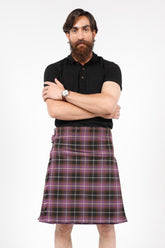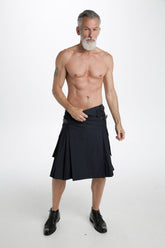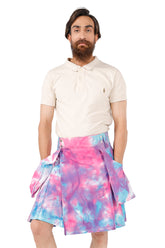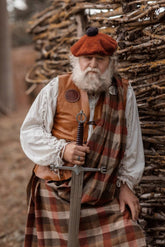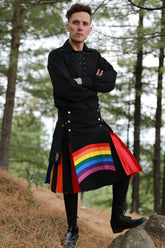How to Choose the Best Kilt Fabric?
Origins of Kilt:
The kilt, a symbol of Scottish heritage, traces its origins to the 16th century. Initially a practical garment worn by Highlanders, it evolved into a cultural emblem synonymous with Scotland. The traditional kilt, characterized by its tartan pattern, gained prominence during the Victorian era. Its roots can be traced to the "feileadh mor," a belted plaid draped over the shoulder and fastened at the waist. Over time, it transformed style and function, becoming a formal attire for special occasions. Today, it stands as a testament to Scottish identity and pride, transcending its utilitarian beginnings to embody a rich tapestry of tradition and history. It is also the uniform of Scottish regiments in the British army and has been worn in battle as recently as World War II.
What is a Kilt?
Curious about the kilt? Let’s learn more about 'What is a Kilt' and its rich history, It is a knee-length pleated skirt, usually made of tartan wool, traditionally worn by men in Scotland and Scottish regiments in the British army. The garment is wrapped around the wearer's body at the natural waist and fastened with straps and buckles on both ends, emerged in the 16th century as the great kilt, a full-length garment whose upper half could be worn as a cloak, and evolved into the small or modern kilt in the 18th century. They are a major element of the traditional national garb of Scotland and are worn for ordinary occasions as well as special events.
Kilt Occasions:
The kilt is a versatile and significant garment in Scottish culture, worn on various occasions. It holds a deep-rooted place in Scottish tradition and is associated with weddings, cultural events, Highland games, and Scottish military traditions. They are suitable for formal events like weddings, black-tie events, and graduation ceremonies, as well as social gatherings such as family reunions, birthday parties, and New Year's Eve celebrations. Additionally, it is appropriate for casual occasions, sporting events, and even formal dinners. The garment's history reflects its evolution from traditional wear to a symbol of masculinity and a fashion statement. The kilt's unique place as everyday wear for ordinary occasions sets it apart from other national costumes. Overall, it is a symbol of Scottish identity and is worn with pride on a wide range of meaningful occasions.
Kilt Fabric Types:
They are a traditional Scottish garment that has evolved over time. Today, kilts can be made from a variety of materials, each with its own unique characteristics. Here are five popular fabrics and what you need to know about them:
Tartan Kilt:
Tartan kilts are a traditional Scottish garment made from tartan fabric, which is typically woven from wool or acrylic wool. The tartan pattern is a distinct pattern of colored stripes and checks that is associated with Scottish culture and traditional clothing. Most tartan wool cloth measures 54” to 60” wide and is woven on a double-width loom, although some are single-width and measure 32” wide. Tartan fabric is available in a variety of weights, from lightweight 11 oz to 13 and 16 oz kilt-weight material. This Traditional Scottish Kilt can be made from a variety of tartan patterns, including clan tartans, universal tartans, fashion tartans, Irish tartans, and Welsh tartans.
Different Weights for Tartan Fabrics:
- Heavy Weight: Heavy-weight tartan wool fabrics weigh around 16oz, making them durable and warm. Traditional kilts predominantly use heavy-weight tartan fabric, which offers greater durability, creasing, and swing. They provide authenticity but can be physically weighty, making them best suited for crafting traditional kilts, Scottish bagpipes, and other fashion items. They are ideal for winter clothing and occasions that require a formal look.
- Medium Weight: Medium-weight tartan wool fabrics weigh around 13oz, offering a balance between warmth and comfort. This tartan fabric offers a balanced combination of warmth, crease-retention, durability, swing, and ease of wear. This versatile material is used not only in kilts but also in soft furnishings, curtains, cushions, and covers. They are suitable for all seasons and occasions, making them a popular choice for kilts.
- Light Weight: Lightweight tartan fabrics weigh less than 11oz, making them comfortable to wear in warm weather. This fabric is suitable for hot climates, providing a cooler wearing experience. However, it requires more regular pressing for crease maintenance. Tartan skirts are often made from lightweight fabric for comfort in warm conditions.
Utility Kilt:
Utility kilts are made from premium-quality, lightweight, and breathable cotton fabric, designed for comfort and practicality. They are adorned with silver-tone metal studs, antique metal chains, fittings, and buttons, and boast stylish pleats and multiple pockets, a comfortable alternative to trousers, reflecting high standards and integrity in their patented utility design. Utility Kilt comes in various styles, such as the rugged Carpenter Kilt, the versatile Work Kilt, the utility-packed Cargo Kilt, the iconic Carhartt Kilt, and the patriotic American Kilt.
Leather Kilt:
Leather kilts are a popular alternative to traditional tartan kilts. They are made from genuine leather, including cowhide, sheepskin, and goatskin, each offering unique textures and finishes. They typically feature a flat front with pleats at the back, fastened with adjustable straps and buckles. Leather kilts are known for their rugged and edgy aesthetic, often associated with alternative fashion subcultures like punk and goth. They come in various types, including Black Leather Kilt, Exotic Leather Kilt, and leather Gladiator Kilt. Leather kilt is versatile and can be worn for casual wear, formal wear, hiking wear, and more. They require special care to keep them in good condition.
Hybrid Kilt:
A hybrid kilt is a modern take on the traditional kilt, combining the classic look with modern fabrics and designs to create a functional and unique piece of clothing, made from a blend of materials, including leather, denim, cotton, and polyester, which makes them highly durable and long-lasting. They are available in a range of colors and designs, including tartan patterns, solid colors, and camouflage prints. Hybrid kilts are equipped with pockets, adjustable straps, belt loops, zippers, and more, making them practical and versatile. They are perfect for any casual occasion or wear on the job. This kilt is a fusion of tradition and innovation, lovingly crafted with meticulous attention to detail.
Denim Kilt:
A Denim Kilt is a chic fusion of denim jeans' rugged appeal and the time-honored elegance of a Scottish kilt, offering a unique and stylish garment for various occasions. Crafted from durable denim fabric, showcases a wrap-around design, often secured with buckles or buttons, and features practical pockets and adjustable straps for added convenience. Denim Kilts are available in a variety of designs, including tartan, stonewashed, and hybrid styles. Suitable for multiple events, these versatile garments can be dressed up or down, making them a practical and fashionable choice for any wardrobe.
Factors to Consider When Choosing Kilt Fabric!
They are a traditional Scottish garment that has been around for centuries. When choosing the right fabric, there are several factors to consider, including the occasion, climate, and personal preferences. Here are some tips to help you choose the best kilt fabric for you:
- Occasion: When choosing a kilt fabric, consider the occasion. For formal events, traditional wool kilts are ideal, as they offer a classic and elegant look. On the other hand, for casual occasions, lightweight cotton or polyviscose kilts are more suitable, as they provide comfort and ease of movement while maintaining a smart appearance.
- Climate: The climate plays a significant role in selecting the right fabric. In warmer climates, lighter fabrics such as cotton or polyviscose are preferable, as they offer breathability and comfort. For colder climates, heavier fabrics like wool are more suitable, providing warmth and insulation. It's essential to consider the climate to ensure that your kilt is comfortable and appropriate for the weather conditions.
- Fabric Weight: Fabric weight is a crucial factor when choosing, medium-weight fabrics offer a good balance of warmth and durability, making them suitable for various occasions. Heavier fabrics are more durable but may be too warm for hot climates, while lighter fabrics are ideal for summer or casual wear. The fabric weight determines your outfit comfort and suitability for different weather conditions.
- Personal Preference: Personal preference plays a significant role in selecting. Wool kilts are favored for their durability and classic look, while cotton or polyviscose blends are preferred for their lightweight and diverse tartan patterns. It's essential to choose a fabric that aligns with personal style and comfort preferences to ensure satisfaction with appearance and feel.
- Budget Consideration: When choosing, budget is an important consideration. Acrylic tartan fabric and poly-cotton blends are budget-friendly options that offer durability at a lower cost. While traditional wool kilts may be more expensive, they are an investment in quality and authenticity. It's important to balance quality and cost to find a fabric that meets both budgetary and quality requirements.
Accessorizing Your Kilt:

When accessorizing your kilt, consider the following key elements to complete your highlandwear outfit. Start from the bottom up, ensuring your brogues are well-matched. Place the kilt pin on a prominent line of the tartan design to add weight to the apron and keep it hanging straight. Choose cufflinks that complement your outfit, whether traditional or rustic, and ensure they coordinate with other accessories. Additionally, consider the practical and aesthetic benefits of wearing a sporran, kilt belt, sgian dubh, and neckwear. These accessories not only add a touch of elegance but also reflect your Scottish heritage. By carefully selecting and coordinating your accessories, you can create a stylish and personalized ensemble that pays homage to tradition and craftsmanship.
Where to Buy a Kilt?
If you're looking to buy a Kilt For Men, Fashion Kilt is a great place to start. With a wide range of styles and colors, offers high-quality kilts that are perfect for any occasion. Whether you're looking for a traditional Scottish kilt or a more modern design, Fashion Kilt has something for everyone. Crafted since 2018, our kilts are not just pieces of clothing, but a legacy. With a commitment to customization and a wide range of options, we cater to all tastes, ensuring both comfort and affordability. Additionally, We pride ourselves on lightning-fast delivery and warm customer service, making the kilt-buying experience as memorable as the garment itself. Trust us for your style that marry heritage with a modern twist, allowing you to stand out in style.
FAQs
What is the history of the kilt?
The kilt, a symbol of Scottish heritage, traces its origins to the 16th century. Initially a practical garment worn by Highlanders, it evolved into a cultural emblem synonymous with Scotland. The traditional kilt, characterized by its tartan pattern, gained prominence during the Victorian era. Its roots can be traced to the "feileadh mor," a belted plaid draped over the shoulder and fastened at the waist. Over time, it transformed style and function, becoming a formal attire for special occasions. Today, it is a testament to Scottish identity and pride, transcending its utilitarian beginnings to embody a rich tapestry of tradition and history.
What are the occasions suitable for wearing a kilt?
They are suitable for a wide range of occasions, including weddings, cultural events, Highland games, Scottish military traditions, formal events, casual occasions, sporting events, and formal dinners. Their versatility makes them a practical and fashionable choice for any wardrobe.
What are the different types of kilt fabrics?
They can be made from a variety of materials, including tartan wool, cotton, leather, denim, and hybrid fabrics. Each fabric has its own unique characteristics, making it suitable for different occasions and preferences.
How do I select the perfect tartan for my kilt?
Choose the ideal tartan by considering your family's heritage or personal preference, ensuring a timeless and meaningful connection to tradition and style.
What accessories should I consider for my kilt?
Enhance your ensemble with carefully chosen accessories, such as a complementary sporran, classic belt with an ornate buckle, symbolic kilt pin, traditional Sgian Dubh, knee-high kilt hose with flashes, ghillie brogues, and optional jacket or vest. These elements create a polished, personalized, and culturally rich look.

